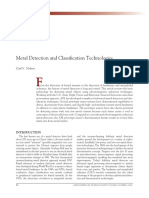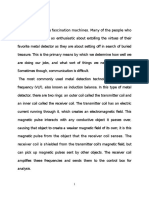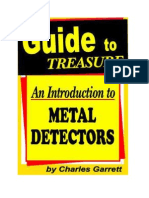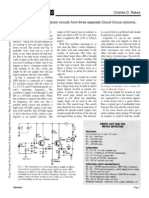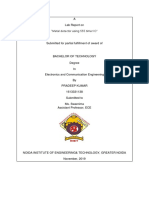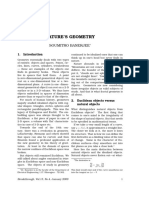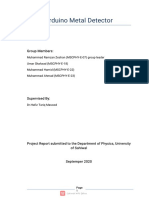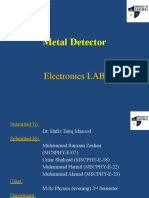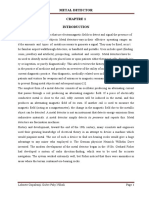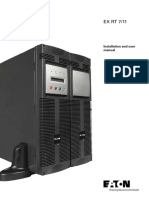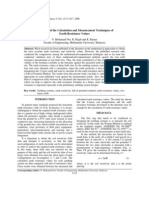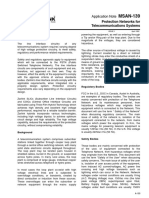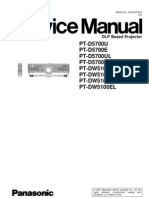METAL DETECTOR
Metal detectors use electromagnetic induction to detect metal. Uses include de-mining (the
detection of land mines), the detection of weapons such as knives and guns, especially at
airports, geophysical prospecting, archaeology and treasure hunting. Metal detectors are also
used to detect foreign bodies in food, and in the construction industry to detect steel reinforcing
bars in concrete and pipes and wires buried in walls and floors.
The simplest form of a metal detector consists of an oscillator producing an alternating current
that passes through a coil producing an alternating magnetic field. If a piece of electrically
conductive metal is close to the coil, eddy currents will be induced in the metal, and this
produces an alternating magnetic field of its own. If another coil is used to measure the magnetic
field (acting as a magnetometer), the change in the magnetic field due to the metallic
object can be detected.
History and development
The first detectors
Toward the end of the 19th century, many scientists and engineers used their growing knowledge
of electrical theory in an attempt to devise a machine which would pinpoint metal. The use of
such a device to find ore-bearing rocks would give a huge advantage to any miner who employed
it. The German physicist Heinrich Wilhelm Dove invented the induction balance system, which
was incorporated into metal detectors a hundred years later. Early machines were crude, used a
lot of battery power, and worked only to a very limited degree. Alexander Graham Bell used
such a device to attempt to locate a bullet lodged in the chest of American President James
Garfield in 1881; the attempt was unsuccessful because the metal bed Garfield was lying on
confused the detector.[1]
Modern developments
The modern development of the metal detector began in the 1930s. Gerhard Fisher had
developed a system of radio direction-finding, which was to be used for accurate navigation. The
system worked extremely well, but Fisher noticed that there were anomalies in areas where the
terrain contained ore-bearing rocks. He reasoned that if a radio beam could be distorted by metal,
then it should be possible to design a machine which would detect metal using a search coil
resonating at a radio frequency. In 1937 he applied for, and was granted, the first patent for a
metal detector. However, it was one Lieutenant Josef Stanislaw Kosacki, a Polish officer
attached to a unit stationed in St Andrews, Fife, Scotland during the early years of World War II,
that refined the design into a practical detector. They were heavy, ran on vacuum tubes, and
needed separate battery packs. The design invented by Stanislaw was used extensively during the
clearance of the German mine fields during the Second Battle of El Alamein when 500 units
were shipped to Field Marshal Montgomery to clear the minefields of the retreating Germans,
�and later used during the Allied invasion of Sicily, the Allied invasion of Italy and the Invasion
of Normandy. As it was a wartime research operation to create and refine the design of the
detector, the knowledge that Stanislaw created the first practical metal detector was kept secret
for over 50 years.
After the war, there were plenty of surplus mine detectors on the market; they were bought up by
relic hunters who used them for fun and profit. This helped to form metal detecting into a hobby.
Further refinements
Many manufacturers of these new devices brought their own ideas to the market. Whites
Electronics of Oregon began in the 50's by building a machine called the Oremaster Geiger
Counter. Another leader in detector technology was Charles Garrett, who pioneered the BFO
(Beat Frequency Oscillator) machine. With the invention and development of the transistor in the
50's and 60's, metal detector manufacturers and designers made smaller lighter machines with
improved circuitry, running on small battery packs. Companies sprang up all over the USA and
Britain to supply the growing demand.
Modern top models are fully computerized, using integrated circuit technology to allow the user
to set sensitivity, discrimination, track speed, threshold volume, notch filters, etc., and hold these
parameters in memory for future use. Compared to just a decade ago, detectors are lighter,
deeper-seeking, use less battery power, and discriminate better.
Larger portable metal detectors are used by archaeologists and treasure hunters to locate metallic
items, such as jewelry, coins, bullets, and other various artifacts buried shallowly underground.
Discriminators
The biggest technical change in detectors was the development of the induction-balance system.
This system involved two coils that were electrically balanced. When metal was introduced to
their vicinity, they would become unbalanced. What allowed detectors to discriminate between
metals was the fact that every metal has a different phase response when exposed to alternating
current. Scientists had long known of this fact by the time detectors were developed that could
selectively detect desirable metals, while ignoring undesirable ones.
Even with discriminators, it was still a challenge to avoid undesirable metals, because some of
them have similar phase responses e.g. tinfoil and gold, particularly in alloy form. Thus,
improperly tuning out certain metals increased the risk of passing over a valuable find. Another
disadvantage of discriminators was that they reduced the sensitivity of the machines.
New coil designs
Coil designers also tried out innovative designs. The original Induction Balance coil system
consisted of two identical coils placed on top of one another. Compass Electronics produced a
new design; the two coils were made in a D shape, and were mounted back-to-back to form a
circle. This system was widely used in the 1970s, and both concentric and D type (or Widescan
�as they became known) had their fans. Another development was the invention of detectors
which could cancel out the effect of mineralization in the ground. This gave greater depth, but
was a non-discriminate mode. It worked best at lower frequencies than those used before, and
frequencies of 3 to 20 kHz were found to produce the best results. Many detectors in the 1970s
had a switch which enabled the user to switch between the discriminate mode and the non-
discriminate mode. Later developments switched electronically between both modes. The
development of the Induction Balance detector would ultimately result in the Motion detector,
which constantly checked and balanced the background mineralization.
Pulse induction
A pulse induction metal detector with an array of coils
At the same time, developers were looking at using a different technique in metal detection
called Pulse Induction. Unlike the Beat Frequency Oscillator or the Induction Balance machines
which both used a uniform alternating current at a low frequency, the pulse induction machine
simply fired a high-voltage pulse of signal into the ground. In the absence of metal, the 'spike'
decayed at a uniform rate, and the time it took to fall to zero volts could be accurately measured.
However, if metal was present when the machine fired, a small current would flow in the metal,
and the time for the voltage to drop to zero would be increased. These time differences were
minute, but the improvement in electronics made it possible to measure them accurately and
identify the presence of metal at a reasonable distance. These new machines had one major
advantage: they were completely impervious to the effects of mineralization, and rings and other
jewellery could now be located even under highly-mineralized 'black sand'. They had one major
disadvantage too: there was no way to incorporate discrimination into a Pulse induction detector.
At least, that was the perceived wisdom of scientists and engineers until Eric Foster, who had run
Location Technology in Ireland for many years, started a new company in Britain and produced
the Goldscan, the first Pulse Induction detector which had the apparent ability to differentiate
between metals. This was a new type of 'junk eliminator' circuit, which relied on the size of the
target as well as its metallic response to give a control that would show positive for a gold ring
and negative for a copper coin. Its ability to differentiate between non-ferrous metals was not an
exact science, but gave unparalleled depth on mineralized soil or sand. Pulse Induction detectors
are now widely used in the construction industry; the Whites PI-150 is an industrial machine
which can detect large objects to 10 feet, using a 12 or 15 inch coil.
Long range locators
These are devices purported to be able to home in on precious metals or other commodities from
distances substantially greater than the relatively short range of a typical metal detector.
Although their builders claim they generally operate on some sort of resonance principle, the
theory of operation is not consistent from device to device, and all such devices, when examined
by scientists and metal detection experts, have proven to be indistinguishable from highly
decorated dowsing rods.
�Uses of metal detectors
Metal detectors in archeology
In England and Wales metal detecting is legal provided permission is granted by the landowner,
and the area is not a Scheduled Ancient Monument or covered by elements of the Countryside
Stewardship Scheme. Voluntary reporting of finds to the Portable Antiquities Scheme or the UK
Detector Finds Database is encouraged. These schemes have their critics, however, including
some archaeologists and metal detectorists. The situation in Scotland is very different. Under the
Scots law principle of bona vacantia,[2] the Crown has claim over any object of any material
value where the original owner cannot be traced. There is also no 300 year limit to Scottish finds.
Any artifact found, whether by metal detector survey or from an archaeological excavation, must
be reported to the Crown through the Treasure Trove Advisory Panel at the National Museums
of Scotland. The Panel then determines what will happen to the artifacts. Reporting is not
voluntary, and failure to report the discovery of historic artifacts is a criminal offense in
Scotland.
Archeology is beginning to recognize the contribution responsible metal detecting provides in
adding to the knowledge of our past. One example is utilizing the skilled use of the metal
detector to examine wide areas such as battlefield sites where surface scatters of metal objects
may be all that survives. This has recently been demonstrated during archaeological work
conducted at Antietam National Battlefield in the United States.[citation needed]
Security screening
Metal detectors at an airport
The first industrial metal detectors were developed in the 1960s and were used extensively for
mining and other industrial applications. A series of aircraft hijackings led the Finnish company
Outokumpu to adapt mining metal detectors, still housed in a large cylindrical pipe, to the
purpose of screening airline passengers as they walked through. The development of these
systems continued in a spin off company and systems branded as Metor Metal Detectors evolved
in the form of the rectangular gantry now standard in airports. In common with the developments
in other uses of metal detectors both alternating current and pulse systems are used, and the
design of the coils and the electronics has moved forward to improve the discrimination of these
systems. In 1995 systems such as the Metor 200 appeared with the ability to indicate the
approximate height of the metal object above the ground, enabling security personnel to more
rapidly locate the source of the signal. Smaller hand held metal detectors are also used to locate a
metal object on a person more precisely.
�Industrial metal detectors
Industrial metal detectors are used in the pharmaceutical, food, beverage, textile, plastics,
chemicals, and packaging industries.
Contamination of food by metal shards from broken processing machinery during manufacture is
a major safety issue in the food industry. Metal detectors for this purpose are widely used and
integrated in the production line.


